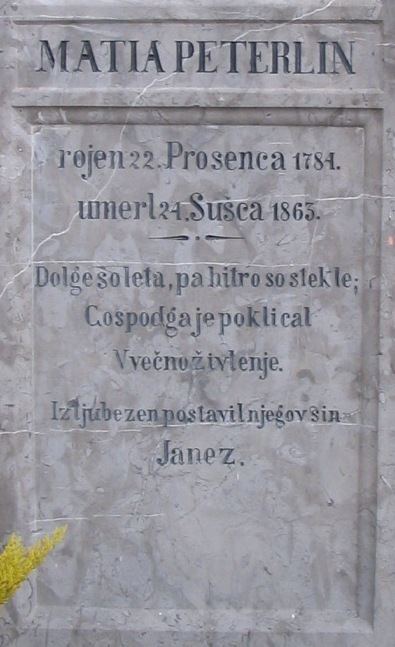 | ||
The standard modern names of Slovene months are derived from Latin names, as in most European languages. There are also archaic Slovene month names, which exist in both a standardized set as well as many variations.
Contents
Standard archaic names
Many of the names in the standardized set of archaic Slovene month names first occur in the Škofja Loka manuscript, written in 1466 by Martin of Loka.
Variant month names
Multiple systems have been used in various Slovene-speaking regions, some of which were based on the names of saints (e.g., jurjevščak 'April', literally 'St. George's'), numbers (e.g., prvnik 'January', literally 'first'), or other features (e.g., vetrnik 'March', literally 'windy'). In the Prekmurje dialect of Slovene, the following system was attested: sečen 'January', süšec 'February', mali traven 'March', velki traven 'April', risalšček 'May', ivanšček 'June', jakopešček 'July', mešnjek 'August', mihalšček 'September', vsesvišček 'October', andrejšček 'November', božič 'December'.
By month
Additional names include brumen (< Italian bruma 'depth of winter'), sečen (related to suh 'dry' or from sek- 'cut'), ledenec and lednik (< led 'ice'), mali božičnjak and malobožičnjak (< mali božič 'Epiphany'), prozimec (probably contamination of prosinec with zima 'winter'), prvnik (< prvi 'first'), and zimec (< zima 'winter'). The name prosinec, associated with millet bread and the act of asking for something, was first written in the Škofja Loka manuscript.
Additional names include sečan and sečen (both related to suh 'dry' or from sek- 'cut'), and sečni mesec (< sek- 'cut'). The name svečan may relate to icicles or Candlemas. This name originates from sičan, written as svičan in the New Carniolan Almanac from 1775 and changed to its final form by Franc Metelko in his New Almanac from 1824. The name was also spelled sečan, meaning "the month of cutting down of trees". In 1848, a proposal was put forward in Kmetijske in rokodelske novice by the Slovene Society of Ljubljana to call this month talnik (related to ice melting), but it has not stuck. The idea was proposed by the priest and patriot Blaž Potočnik. A name of February in Slovene was also vesnar, after the mythological character Vesna.
Additional names include brezen and breznik (both from breza 'birch'), ebehtnik (< Middle High German ebennaht 'equinox'), gregorščak (< Gregor '(Saint) Gregory'), marcij, postnik (< post 'Lent'), traven (< trava 'grass'), and tretnik (< tretji 'third'). The name sušec was first written in the Škofja Loka manuscript.
Additional names include brezen (< breza 'birch') and jurijevščak (< Jurij '(Saint) George'). The name mali traven was first written in the Škofja Loka manuscript.
Additional names include cvetičnik and cvetnar (both < cvet 'flower'), majnik, mlečen (< mleč 'chicory'), risalščak and rusalščak (< risale/rusale 'Pentecost'), rožni mesec (< roža 'flower'), and sviben (< sviba '(flowering of) dogwood'). The name veliki traven was first written in the Škofja Loka manuscript.
Additional names include bobov cvet (literally, 'broad bean blossom') ivanjščak and šentjanževec (both referring to Saint John's Day), klasen (< klas 'head of grain'), kresnik (< kres 'bonfire', referring to Midsummer), prašnik (literally, 'stamen'), rožencvet and rožni cvet (both 'flower blossom'), and rženi cvet ('rye blossom').
Additional names include jakobnik and jakobščak (both referring to Saint James's Day), pšeničnik (< pšenica 'wheat'), and žetnik (< žetev 'reaping').
Additional names include kolovožnjak, medmašnik, mešnjak, otavnik, porcijunkula, velikomašnjak, and vršenj.
Additional names include jesenik, jesenščak, kozoprsk, miholščak, poberuh, and šmihelščnik.
Additional names include kozoprsk, listopad, lukovščak, moštnik, obročnik, repar, repnik, vinec, and vinščak.
Additional names include andrejščak, gnilolist, listognoj, martinščak, vsesvečnjak, and vsesvečak.
Additional names include kolednjak and veliki božičnjak (< božič 'Christmas').
